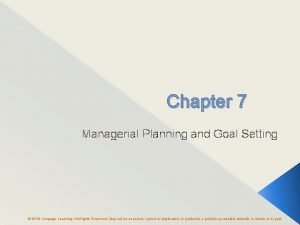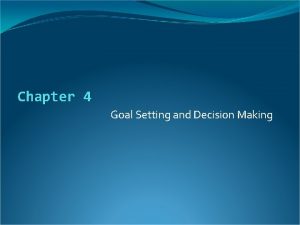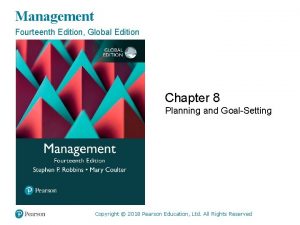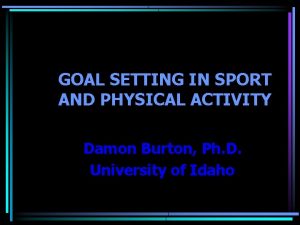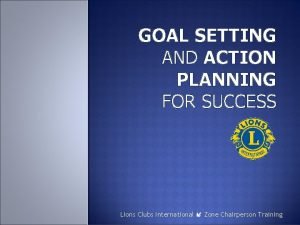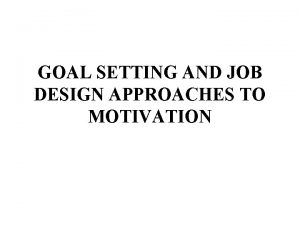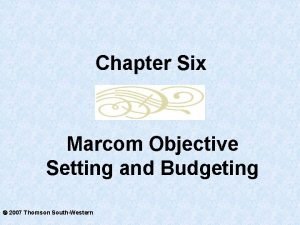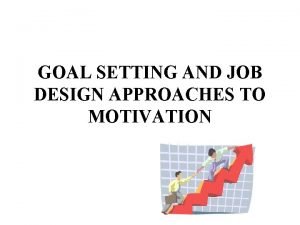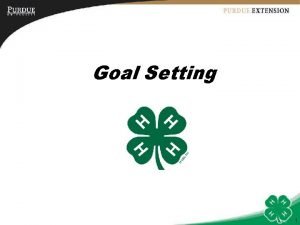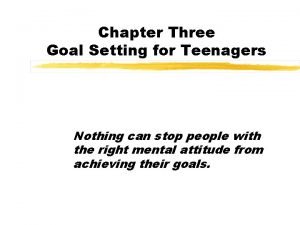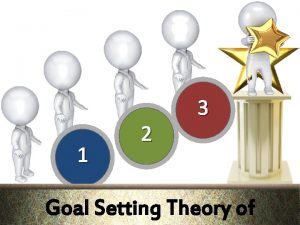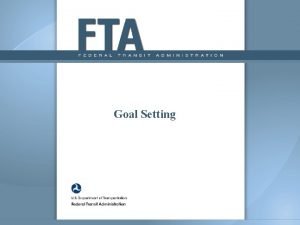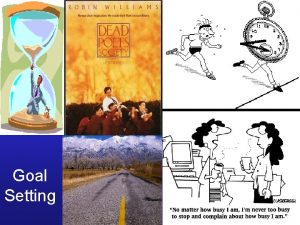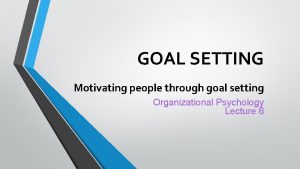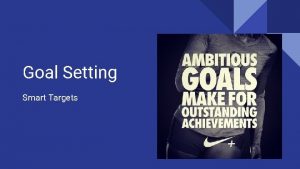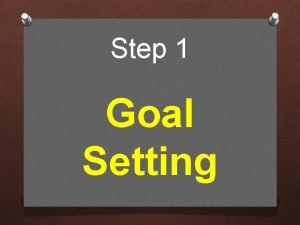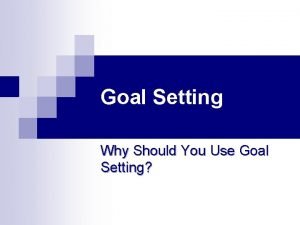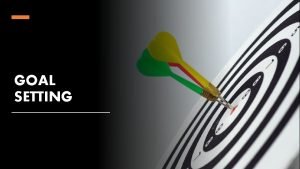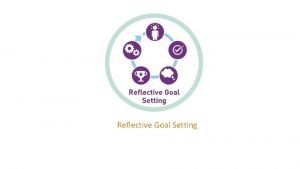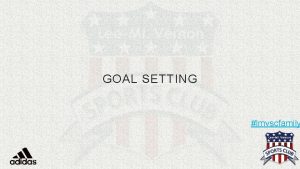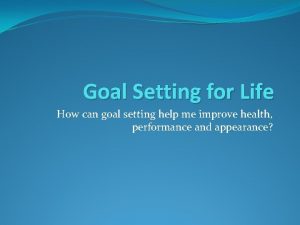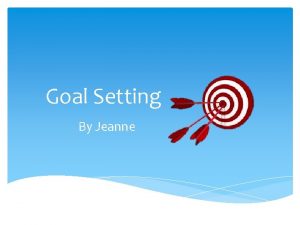Setting and Awarenes s Clarity A goal must
















- Slides: 16

Setting and Awarenes s

Clarity. A goal must be specific and clear to give us direction. Principles of Effective Goal Setting Challenge. An easy or tedious goal is demotivating. But it is also important to be realistic. Commitment. There is no point in setting a goal if you are only going in half heartedly. Your goals will require you to try hard. Think about time constraints at this point too. Feedback. Look at your process goals to check you are on track. Task complexity. Be realistic with timescales. Break down into performance and process goals.

Helpful for your big dream goal. Self Confidenc e Goals Easier goals to keep motivation high. Should be goals you can achieve on a regular/daily basis. Examples include: drinking 2 litres of water everyday, a 4 k run, 10 pull ups, doing a coloured circuit in the wall.

Shouldn’t be easy but should be reasonable. Realistic Goals Tougher to make these goals as they need to be more challenging than self-confidence goals. These goals should be aimed towards pushing you in the right direction to achieving your dream goal, so focusing in on the areas you need to improve on. Examples include: Training as many days as you can per week, climbing routes in different styles at your limit, getting better on a hangboard.

This goal will push you to fail and grow at the same time. Dream Goals/Stretc h Goals Rarer to accomplish these goals, maybe one a year if you are lucky. If you can check things of this list regularly they are not challenging enough and fall into the realistic goal category. Important to challenge yourself with things that seem out of reach. This goal is important for stepping outside of your comfort zone, without that its very difficult to see any improvement. Examples include: A dream climb for you. E. g for me Big Bang was my stretch goal.

Quotes on Goal Setting Michaela Kirsch: “ Whether I actually accomplish the goal or not, I am learning and bettering myself along the way. Maybe I won’t ever be able to do some of the items on my list, but if I can achieve just one of my dreams it is well worth the effort. ” Steve Mclure: “ The key is to choose a goal that pushes you the right amount, and fits with your personality, drive and lifestyle. It must be realistic, but it’s not supposed to be easy! The harder the better. The biggest buzz comes to those who flirt with the edge!” Shauna Coxsey: “As soon as you put pen to paper, your goal becomes real. I remember being petrified to write down that I wanted to be world number one – but it became a lot less daunting once I had. It was a breakthrough moment and crystalised what I was training for. ”

Outcome Goals: These are great to have but are geared towards a result that you may not achieve. This can leave you feeling a bit deflated. With outcome goals try to set a realistic goal and a dream goal: Goal Setting – Important to have a direction to aim towards Realistic Goal Example: Bob has climbed sport 7 b 6/7 times now and a couple of 7 b+’s, he’d like to consolidate at 7 b across a variety of styles and try to flash a 7 b with good beta. Treat this as your mid-term/stepping stone goal. Dream Goal Example. Having climbed 7 b+ Bob would really like to push it further and try to climb 7 c/+. He’s got one in mind that suits his style, lets say Dominatrix at Kilnsey. Ideally he’d like to get it within a year but knows this may take a little longer.

Performance Goals: What do you need to focus on to be more likely to achieve your outcome goal. Is it head game, technique, power? What’s causing you to Plateau or hold you back from the next level? Mental Performance Goal: Bob is struggling with his on-sight/flash climbing. He’s fine once he knows he can do the moves but the fear of falling on a new route takes over because he lacks confidence in being able to do the moves. Bob needs to work fall practice into his training routine building up slowly with his climbing partner. He needs to gain more confidence to try hard with that ’one more move mentality’ rather than saying take. Tactical Performance Goal: Bob struggles with reading sequences on a route, he tends to get wrong handed and moves feel more difficult than they should. Bob needs to practice route reading sequences, look at routes or boulders before just pulling on. He needs to become more efficient with his movement. Physical Performance Goal: Bob struggles with his Power Endurance, he can do all the moves on the route but when it comes to a hard sequence of moves he Powers out mid way through. After a couple of minutes rest he can then do the moves. Bob needs to train his Power Endurance for a hard sections on routes.

Mental Process Goal: Process Goals: The steps you take to Improve Your Performance Goals. Use these and your Performance Goals as Markers towards the Outcome and to find motivation for the right reasons Bob is going to start by taking some falls after having clipped the draw. He tells his partner he’s going to clip the 4 th draw and then drop off. After a few times doing this and being happy, he progresses a move past the draw each time. Now he’s progressed with this he puts it into a real situation. As he gets on a route he climbs to a point where he says watch me here I’m pumped to his partner, his partner responds back saying I’m watching. He falls off a move or two later, this is what he will do when trying to on-sight a new route gaining that confidence to try hard. Tactical Process Goal: Bob will chat through a sequence of a new route on video going into as much detail as possible – where to clip, which bit is tricky etc. Then video himself climbing the route and analyse where he did things differently and what went to plan! When bouldering he will try problems, attempting to come up with 3 different solutions to build up his knowledge of movement but also to think about which way worked best and why. Physical Process Goal: Bob can work this into his training regime. To increase power endurance he can either do 4 x 4’s on boulder problems, 15 – 20 move board circuits, Campus board feet on, or 6 x 2 on routes near his limit.

Comfort seeking Thinking in all or nothing ways The Minds Limiting Tendencies Tricking ourselves into bypassing stress Leads to getting distracted. The mind doesn’t like stress and will do anything to escape it. The motive here is evasion. Your mind can create concepts of situations that you haven’t yet engaged in. If the situation is unknown these concepts are false. Your mind is lying to you.

Attention is all you can really control. Focus attention on possibilities. E. g breathing to slow heart rate Awareness Use attention to direct your mind’s thinking processes. Thinking isn’t something you can completely control. Fear is about what might happen and this originates from your thinking mind. Comfort Zone is your mind’s area of expertise. The uncomfortable zone contains the stress and chaos. This is where it will create false preconceptions.

Push into uncomfortable zone, experience it, process it. Expanding your Comfort Zone Expands your mind’s understanding of what is possible. Embrace the stress generated in a climbing experience. Tricks don’t help you grow as they don’t help you learn. It is just a way of attempting to ignore the stress. Try not to label your attempt as success or failure. This hinders the learning process.

Set an intention – maybe that is aiming to get past your high point on a route. Embracing your Fears Head on Witness and accept the doubts and attempts to avoid the route. E. g. the conditions aren’t good enough. Delay reacting to these doubts and take some time to process them. Redirect your attention back to your intention. E. g. Ok I’m aiming to get past my high point. Small steps, think about a less threatening way to engage. E. g I’m going to climb to my high point first because that is familiar ground and still in the comfort zone.

Underthink and do poor risk assessment. Are you an Intuitive Climber? They attempt to smash through the stress by climbing quickly. Feelings of discomfort at rests. Rush into cruxes without resting enough and collecting the information for an effective plan. Known for taking wilder falls that are out of control. The positive to this is you can climb faster and more continuously which can minimize time in strenuous positions.

Overthink the information at hand. Are you an Analytical Climber? Can lead to stalling on a climb. Climb slowly. Distracted by the over thinking, end up second guessing and hanging out too long in strenuous positions. This climber has more of a tendency to say ‘take’. The positive to this is that you take time to check your options and avoid getting in dangerously over your head.

Identify an end point. E. g next rest, bolt or piece of gear on trad if possible Combining Analytical and Intuitive Next assess the fall potential. Will you be in a yes or a no fall zone. What’s the angle of the climb and obstacles? Finally identify the Path of Least Resistance, will one sequence lead you to a dead end. Get ready to go! This is where intuition should kick in. You’ve analysed the climb so move with confidence.
 Professional goals for ttess
Professional goals for ttess Characteristics of goal setting
Characteristics of goal setting Decision making and goal setting
Decision making and goal setting Chapter 8 planning and goal-setting
Chapter 8 planning and goal-setting Goal commitment
Goal commitment Goal setting and action planning chart example
Goal setting and action planning chart example Three w's of goal setting
Three w's of goal setting Goal setting
Goal setting Which of the following is not a marcom budgeting method?
Which of the following is not a marcom budgeting method? Agile goal setting
Agile goal setting Goal setting jeopardy
Goal setting jeopardy Goal setting theory
Goal setting theory Objectives of goal setting
Objectives of goal setting Michael phelps motivational video
Michael phelps motivational video Christian goal setting
Christian goal setting Short term goals for teenagers
Short term goals for teenagers Goal setting theory
Goal setting theory

